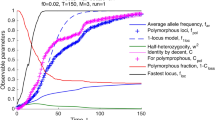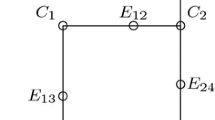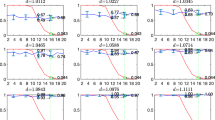Summary
The population genetics of unequal crossing over was examined for an infinite population with random mating. The following cases were considered:
-
1.
There is an initial portion of duplicated genes which offer the opportunity for unequal crossing over, but the primary event leading to the duplication does not occur any more (model 1a).
-
2.
This primary event occurs with a certain (small) probability (model 1b). For both possibilities the long-term consequences for the distribution of “alleles” (i.e. the single gene, the duplicated gene, the triplicated gene etc.) were considered with the following additional assumptions:
-
1.
No selection.
-
2.
Selection with maximum fitness for an optimum “allele length” (i.e. number of gene repeats).
-
3.
For model 1a, selection with general advantage of longer alleles over shorter ones was also examined.
The results are briefly the following: In model 1a under assumption 1 the distribution of allele length tends with increasing generation number to a stationary state which depends on the initial allele distribution (i.e. on the initial frequency of the duplicated gene) but not on the frequency, P, of unequal crossing over; the stationary frequencies of the alleles decrease with increasing allele length. Under assumption 2 there is likewise a stationary allele distribution, but this depends on P as on the strength of selection and not on the initial allele distribution; it is concentrated more or less tightly around the optimal allele length. Under assumption 3 no stationary state seems to be reached: the mean and the standard deviation of the allele distribution increase steadily with the generation number. In model 1b under assumption 1, with certainty no stationary distribution exists. Under assumption 2 the situation is the same as that in model 1a; the stationary distribution of allele length is identical with that in model 1a for the same P and same selection strength, quite independent of the probability of the primary event.
The results were discussed with respect to empirical examples in which unequal crossing over is expected to be important, for example human haptoglobins, immune globulin determining cistrons, and nucleolus organizer regions. The consequences of selection relaxation were considered.
Similar content being viewed by others
References
Black,J.A., Dixon,G.H. (1968). Amino acid sequence of the alpha chains of human haptoglobins and their possible relation to the immunoglobin light chains. Nature 218, 736
Bridges,C.B. (1936). The bar “gene”, a duplication. Sci. 83, 210
Britten,R.J., Kohne,D.E. (1968). Repeated sequences in DNA. Sci. 161, 529
Bross, K., Krone,W. (1972). On the number of ribosomal RNA genes in man. Humangenetik 14, 137
Crow,J. F., Kimura,M. (1970). An introduction to population genetics theory. New York-Evanstone-London: Harper & Row
Dayhoff,M.O. (1972). Atlas of protein sequence and structure, Vol. 5. Silver Spring, Maryland: Nat. Biomed. Res. Found.
Delovitch, T.L., Baglioni,C. (1973). Estimation of light-chain gene reiteration of mouse immunoglobin by DNA-RNA hybridization. Proc.Nat.Acad.Sci. Wash. 70, 173
Dixon,G.H. (1966). Mechanisms of protein evolution. Essays Biochem. 2, 148
Fisher,R.A. (1922). On the dominance ratio. Proc.Roy.Soc.Edinburgh 42, 321
Giblett,E.R. (1969). Genetic markers in human blood. Oxford-Edinburgh: Blackwell
Haldane,J.B.S. (1932). The causes of evolution. London: Longmans Green
Harris,H. (1970). The principles of human biochemical genetics. Amsterdam-London: North Holland
Hilschmann,N., Barnikol,H.U., Hess,M., Langer, B., Ponstingl,H., Steinmetz-Kayne, M., Suter, L., Watanabe,S. (1969). Structure and formation of antibodies. In: Current problems in immunology (Bayer-Symposium I), O. Westphal, H.E.Bock, E.Grundmann, Eds., p.69. Berlin-Heidelberg-New York: Springer
Keyl,H.G. (1966). Increase of DNA in chromosomes. In: Chromosomes today, Vol. 1, C.D.Darlington, K.R.Lewis, Eds., p.99. London: Oliver & Boyd
Kohne,D.E. (1970). Evolution of higher-organism DNA. Q.Rev.Biophys. 3, 327
Lewis,E.B. (1951). Pseudoallelism and gene evolution. Cold Spring Harbor Symp.Quant.Biol. 16, 159
Li,C.C. (1955). Population genetics. Chicago: Univ. of Chicago Press
May,H.G. (1917). Selection for higher and lower facet numbers in the bar-eyed race ofDrosophila and the appearance of reverse mutations. Biol.Bull. 33, 361
Mayo,O. (1970). The role of duplications in evolution. Heredity 25, 543
Metz,C.W. (1947). Duplication of chromosome parts as a factor in evolution. Amer.Natur. 81, 81
Nance,W.E. (1963). Genetic control of hemoglobin synthesis. Sci. 141, 123
Natarajan, A.T., Gropp, A. (1971). The meiotic behavior of autosomal heterochromatic segments in hedgehogs. Chromosoma (Berl.) 35, 143
Natarajan, A.T., Sharma,R.P. (1971). Initiated uridine induced chromosome aberrations in relation to heterochromatin and nuclear organization inMicrotus agrestis L. Chromosoma (Berl.) 34, 168
Nei,M., Kojima, K.-I., Schaffer,H.E. (1967). Frequency changes of new inversions in populations under mutation-selection equilibria. Genet. 57, 741
Ohno,S. (1970). Evolution by gene duplication. Berlin-Heidelberg-New York: Springer
Ohno,S. (1972). Origin, maintenance and significance of genetic polymorphism. In: The biological significance of the histocompatibility antigens. Report on a colloquium held at Titisee (Schwarzwald), October 14–15, 1971, E.Günther, E.Albert, F.Kueppers, K.Bender, Eds., Humangenetik 14, 173
Schull,W.J., Neel,J.V. (1965). The effect of inbreeding on japanese children. New York: Harper & Row
Smithies,O. (1964). Chromosomal rearrangements and protein structure. Cold Spring Harbor Symp.Quant.Biol. 29, 309
Smithies,O., Connell,G.E., Dixon,G.H. (1962). Chromosomal rearrangements and the evolution of haptoglobin genes. Nature 196, 232
Spofford,J.B. (1969). Heterosis and the evolution of duplications. Amer.Natur. 103, 407
Stephens,S.G. (1951). Possible significance of duplication in evolution. Adv.Genet. 4, 247
Storb,U. (1972). Quantitation of immunoglobin genes by nucleid acid hybridization with RNA from myeloma and spleen microsomes. J.Immunol. 108, 755
Sturtevant, A.H. (1925). The effects of unequal crossing over at the bar locus in drosophila. Genet. 10, 117
Sturtevant, A.H., Morgan, T.H. (1923). Reverse mutation of the bar gene correlated with crossing over. Sci. 57, 746
Tice,S.C. (1914). A new sex-linked character inDrosophila. Biol.Bull. 26, 221
Wright,S. (1929). The dominance of bar over infra-bar inDrosophila. Amer. Natur. 63, 1034
Yunis,J.J., Yasmineh,W.G. (1971). Heterochromatin, satellite DNA, and cell function. Sci. 174, 1200
Zeleny,C. (1919). A change in the bar gene of drosophila involving further decrease in facet number and increase in dominance. J.Gen.Physiol. 2, 69
Zeleny,C. (1921). The direction and frequency of mutation in the bar-eye series of multiple allelomorphs ofDrosophila. J.Exp.Zool. 34, 203
Zeleny,C. (1922). The effect of selection for eye facet number in the white bar-eye race ofDrosophila melanogaster. Genet. 7, 1
Author information
Authors and Affiliations
Rights and permissions
About this article
Cite this article
Krüger, J., Vogel, F. Population genetics of unequal crossing over. J Mol Evol 4, 201–247 (1975). https://doi.org/10.1007/BF01732983
Received:
Revised:
Issue Date:
DOI: https://doi.org/10.1007/BF01732983




